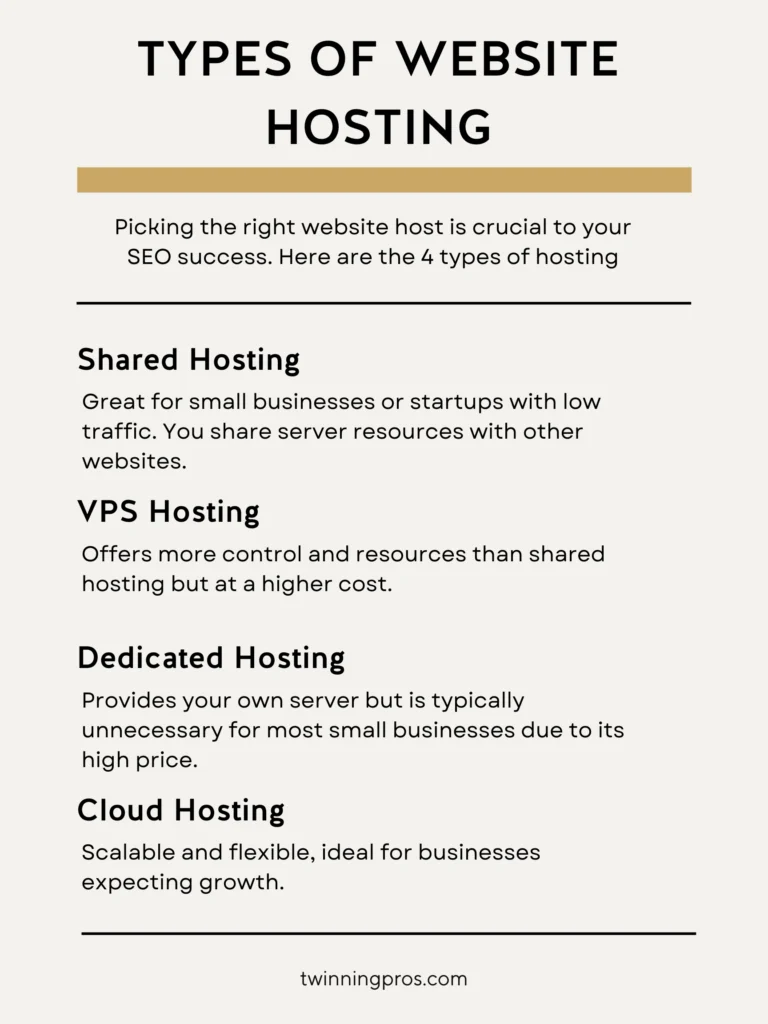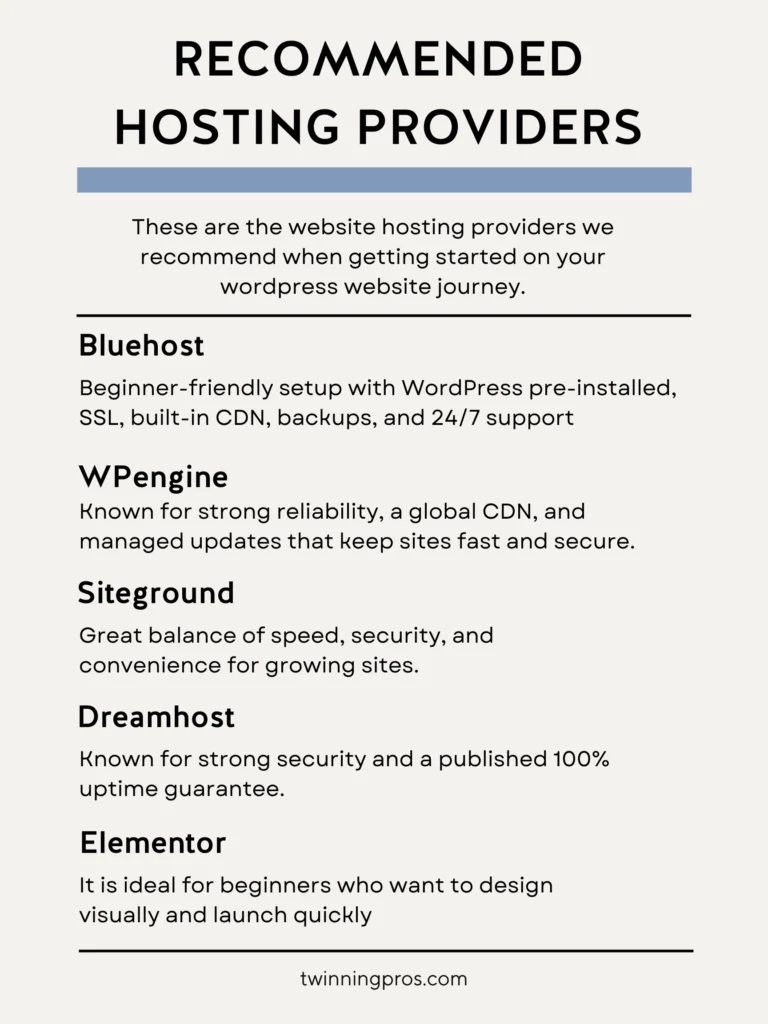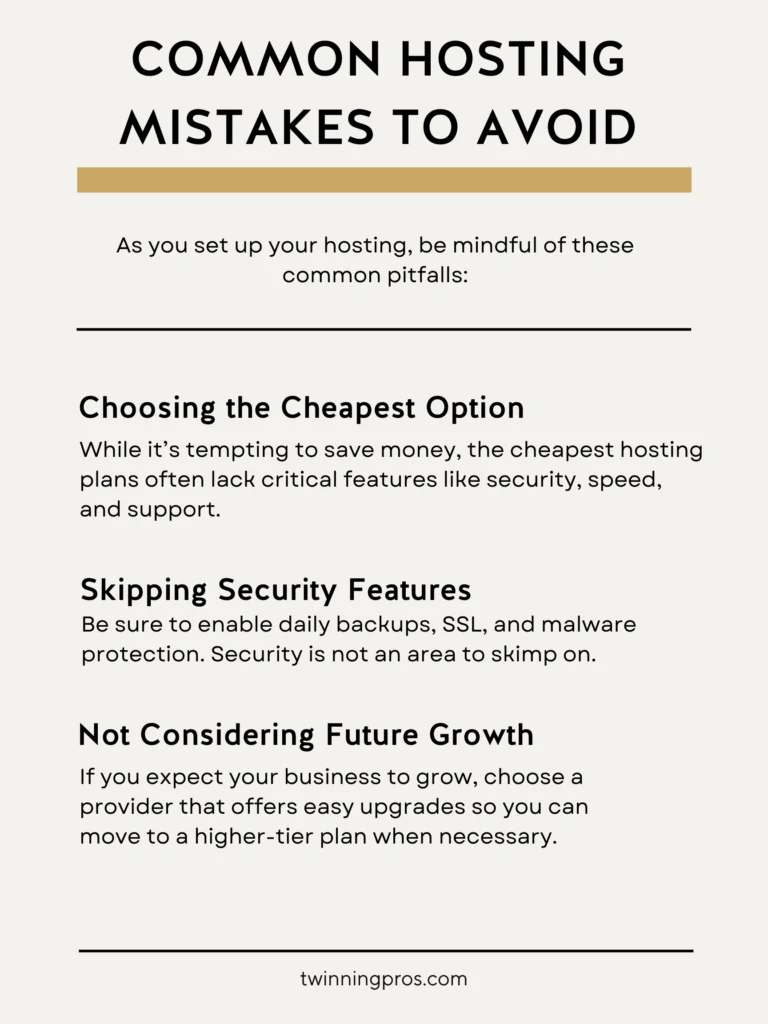Setting up your website hosting is a critical step in bringing your business online. But with so many options and technical terms, where do you even start? For many business owners, the technical side of web hosting can feel overwhelming. Do I need shared hosting or something else? What’s an SSL certificate? Why does any of this matter?
Don’t worry, we’ve got you covered! In this guide, we’ll break down the process of setting up your website hosting into simple, actionable steps so you can get your website live and running smoothly. Let’s dive in!
Table of Contents
What Is Website Hosting and Why Does It Matter?
Website hosting is essentially the home where your website lives on the internet. When someone visits your domain (e.g., www.yourbusiness.com), the hosting provider is what serves up your website’s content. Think of hosting as renting digital space for your website. Without it, your site wouldn’t be accessible online.
Your hosting provider can significantly affect your website’s speed, security, and uptime. A poor hosting choice can lead to slow load times, frequent downtime, and security vulnerabilities—issues that can harm your credibility and drive potential customers away. That’s why it’s essential to pick the right hosting solution for your business from the start.
If you’re unsure about how to choose the perfect domain name to pair with your hosting, check out our post on How to Choose the Perfect Domain Name for Your Business: 5 Proven Tips for Success
How to Choose the Right Web Hosting Provider
Before setting up your hosting, it’s crucial to choose the right provider. Here are some key factors to consider:
Types of Hosting:
- Shared Hosting: Great for small businesses or startups with low traffic. You share server resources with other websites.
- VPS Hosting: Offers more control and resources than shared hosting but at a higher cost.
- Dedicated Hosting: Provides your own server but is typically unnecessary for most small businesses due to its high price.
- Cloud Hosting: Scalable and flexible, ideal for businesses expecting growth.
For more insights on building an effective online presence, you might also find our post on Why Website Design Is Important in 2025 helpful.

Recommended Providers:
- Bluehost – Beginner-friendly setup with WordPress pre-installed, plus a free domain for the first year, SSL, built-in CDN, backups, and 24/7 support. It’s also listed on WordPress.org’s hosting page as a recommended provider.
- WPEngine – A premium, WordPress-only host with built-in performance, security, automatic daily backups, free SSL, staging environments, and 24/7 expert support. It’s great for businesses that want hands-off maintenance and developer tools. Known for strong reliability, a global CDN, and managed updates that keep sites fast and secure.
- Elementor – If you want an all-in-one build + host experience, Elementor pairs its visual drag-and-drop editor with managed WordPress hosting on Google Cloud, plus Cloudflare CDN and WordPress pre-installed. It is ideal for beginners who want to design visually and launch quickly. Hosting plans include Elementor Pro features (templates, Theme Builder, widgets) for end-to-end site creation.
- SiteGround – Runs on Google Cloud with built-in caching, CDN, daily backups, staging, auto-updates, and a smart WAF. It is backed by fast 24/7 expert support. Great balance of speed, security, and convenience for growing sites.
- DreamHost – Value-packed plans with free domain (year 1), unlimited free SSL, daily automated backups, NVMe storage, and a clean custom dashboard, plus a 30-day money-back guarantee. Known for strong security and a published 100% uptime guarantee.

What to Look For:
- Uptime Guarantees: Look for 99.9% uptime guarantees to ensure your site stays accessible.
- Customer Support: 24/7 support is a must, especially if you’re new to managing a website.
- Security: Make sure your provider offers SSL certificates, daily backups, and malware protection.
Step-by-Step Guide to Setting Up Your Website Hosting
Ready to get your hosting set up? Follow these steps to get your website live in no time:
Step 1: Choose Your Hosting Provider
Start by signing up with one of the recommended providers. Each will guide you through the process of selecting a hosting plan. Most small businesses will do well with shared hosting to start, but VPS or cloud hosting are good options if you anticipate rapid growth.
Once you’ve chosen your provider and plan, create an account by entering your business details.
For those starting their website for the first time, our guide on How to Create a Blog can also provide valuable insights.
Step 2: Register or Connect Your Domain
If you haven’t already purchased a domain, most hosting providers allow you to register one directly through them. If you already own a domain, you’ll need to connect it to your hosting provider.
For example, if you registered your domain through GoDaddy (https://www.godaddy.com), you’ll need to update your DNS settings to point to your hosting provider. Most hosting providers will offer a step-by-step guide to walk you through this process.
Step 3: Set Up SSL for Security
An SSL (Secure Sockets Layer) certificate is essential for securing your website and gaining customer trust. It encrypts data sent between your website and visitors, protecting sensitive information.
Most hosting providers offer free SSL certificates. Simply navigate to your hosting dashboard and enable SSL under the security settings. Your hosting provider will automatically configure the certificate for your domain.
Step 4: Install WordPress (or Your Chosen CMS)
If you’re building your website using WordPress, most hosting providers offer a one-click install option. This makes it incredibly easy to get started. Once installed, you can log into your WordPress dashboard to configure your website’s appearance, content, and plugins.
For other content management systems (CMS), your hosting provider will typically provide similar installation instructions.
Interested in optimizing your website for better results? Don’t miss our tips on 5 Simple SEO Tricks You Can Use As a Beginner To Boost Your Website’s SEO
Common Hosting Mistakes to Avoid
As you set up your hosting, be mindful of these common pitfalls:
- Choosing the Cheapest Option: While it’s tempting to save money, the cheapest hosting plans often lack critical features like security, speed, and support.
- Skipping Security Features: Be sure to enable daily backups, SSL, and malware protection. Security is not an area to skimp on.
- Not Considering Future Growth: If you expect your business to grow, choose a provider that offers easy upgrades so you can move to a higher-tier plan when necessary.
By avoiding these mistakes, you can ensure your website runs smoothly and securely, giving you peace of mind as your business grows.
For more insights into growing your online presence and business, read our guide on Why SEO Should Be the Foundation of Your Digital Marketing Strategy

Next Steps After Setting Up Your Hosting
Once your hosting is set up, here’s what you should do next:
- Install Essential Plugins: If you’re using WordPress, install key plugins for SEO, security, and caching (e.g., Yoast SEO, Wordfence for security, and WP Super Cache for faster load times).
For more detailed recommendations on which SEO tools to use, check out What is SEO and Why It Matters for Small Businesses
- Optimize for Speed: Compress images and enable caching to ensure your site loads quickly. A fast website provides a better user experience and can boost your SEO ranking.
For more insights on improving your website performance, visit our post on The Importance of Mobile Optimization: How to Make Your Website Mobile-Friendly for Better User Experience and SEO.
- Set Up Google Analytics: Track your website’s traffic and performance using Google Analytics. This tool will help you understand visitor behavior and optimize your website for better results.
Related Reading: Why Google Analytics is a Must-Have Tool for Small Businesses
Conclusion: Your Website Hosting is the Foundation for Your Online Success
Setting up website hosting may seem complex, but by following these steps, you can get your site live in no time. Hosting is the foundation of your website’s performance, security, and overall success, so investing in the right provider and setup is key.Ready to take the next step in building your business online? Contact Twinning Pros today to get expert guidance on web hosting, website design, and SEO strategies. We’re here to help you every step of the way as you create a strong, reliable online presence.
Website hosting FAQ’s
Can I host my own website for free?
Yes, but it comes with limits. Free plans are fine for simple, low-traffic sites; most still require paying for a custom domain and may restrict bandwidth or features. For a business site, choose paid hosting for SSL, backups, and reliable uptime.
Which web hosting is best for beginners?
Start with reputable shared hosting or managed WordPress that includes one-click installs, free SSL, daily backups, and 24/7 support. Good beginner options include Bluehost, WPEngine, SiteGround, and DreamHost.
How much will it cost to host my website?
Expect basic shared hosting promo rates around $2.99–$7.99/month, with regular pricing typically near $7.99/month, plus about $14.99/year for a domain. Managed WordPress and VPS plans cost more, but add performance and support.
Can I host my website by myself?
Technically yes, but it’s not practical for live sites. Self-hosting requires 24/7 uptime, a static IP, server setup, security hardening, and your own backup system. Most users are better off with a professional host.
What are the 7 C’s of a website?
Clarity (what you do), Content (useful info), Credibility (trust signals like SSL and reviews), Conversion (clear CTAs), Crawlability (SEO basics), Core Web Vitals (speed and stability), Compliance (privacy, accessibility).
Can ChatGPT build me a website?
ChatGPT can generate site copy, page outlines, and production-ready HTML/CSS/JS or WordPress guidance, and walk you through setup. You’ll still need a platform or developer to deploy and host the site.
Is GoDaddy an hosting site?
Yes. GoDaddy is a domain registrar that also sells shared, WordPress, and VPS hosting plans; you can point a GoDaddy domain to any host or use their hosting directly.
SEO for Beginners
Learn from the SEO Strategist who has 75+ first page Google rankings under her belt.
We’re marketing nerds and business strategists that have generated millions of dollars in client revenue. We're sharing the systems and strategies to help your growing business with marketing that actually converts.
We're Tiffany + Tabatha

Comments